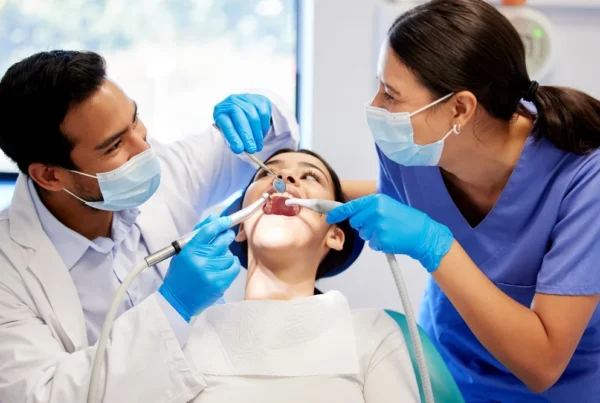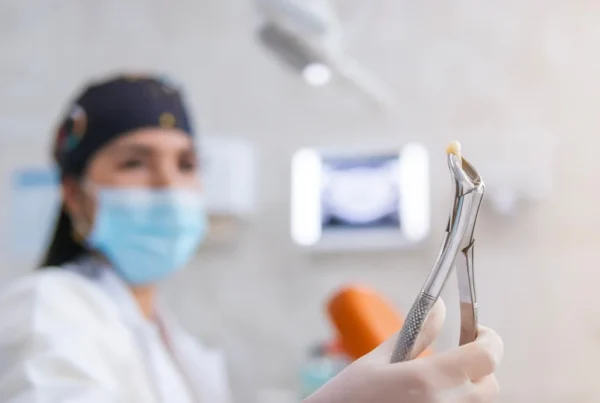Professional guidance during teeth removal surgery combines modern technology, patient education, and comprehensive aftercare for optimal outcomes. Most tooth extractions require 30-60 minutes with immediate recovery and healing over 7-14 days. Grand Prairie patients benefit from advanced 3D imaging, personalized sedation options, and responsive post-operative support throughout their surgical experience. Expert guidance ensures safety, comfort, and successful healing from consultation through complete recovery.
Providing professional guidance during teeth removal surgery is essential for patient well-being and successful outcomes. At Grand Prairie Family Dental, the use of modern technology enhances the precision of each procedure, while personalized patient education and responsive aftercare from professionals offer comprehensive support through all stages of the surgical experience. Dr. Behrooz Khademazad’s 34 years of dental expertise in Grand Prairie ensures that every patient receives the highest level of professional guidance throughout their surgical journey.
Understanding Teeth Removal Surgery
The effectiveness of teeth removal surgery is greatly influenced by the patient’s understanding and preparation for the procedure. Achieving a positive outcome from this intricate dental procedure requires both a skilled dentist and an informed patient working together. It is the mutual responsibility of the dental practitioner and the patient to ensure a well-informed process takes place throughout treatment.
An advanced comprehension of the surgery’s requirements sets the foundation for successful teeth removal outcomes. This involves the dentist explaining the technical aspects of the procedure, including the tools used, the biological structures affected, and the reasons behind each surgical step. An informed patient is better prepared mentally and can follow pre and post-operative instructions more accurately for optimal healing.
Patient preparation becomes a critical component that helps mitigate pre-surgery anxieties effectively. This preparation includes discussing the possible sensations during surgery with or without anesthesia, the duration of the surgery, and the recovery timeline. When patients know what to expect, they are less likely to experience undue stress or surprise, which can aid in their overall recovery process.
The dentist’s surgical expertise remains imperative, but it must be complemented by the patient’s comprehensive grasp of the process. Knowledgeable patients tend to adhere more strictly to post-operative care guidelines and engage in active discussions about their health, which can lead to a smoother surgical experience and quicker healing times.
Detailed Understanding of the Teeth Removal Process
The success of teeth removal surgery largely depends on the patient’s understanding of the entire process, which includes the preparation, the surgery itself, and the postoperative period. A thorough comprehension of these stages can significantly lessen patient anxiety and improve cooperation during treatment.
Pre-surgical preparation represents the first crucial stage where patients receive guidance on the specifics of the surgery. This stage covers everything from fasting requirements to the necessary preoperative medications or washes, aiming to physically and mentally ready the patient for what is to come. Knowledge about what preparation entails allows patients to feel more in control and less apprehensive about the upcoming procedure.
The technical execution becomes the second stage, where the dentist performs the actual removal of the tooth with precision. This involves steps like incising the gum to expose the tooth and bone, removing any obstructing bone tissue, and the precise extraction of the tooth. Patients who understand the technical execution, including the reasons for each action and the tools used, are likely to feel more at ease during the procedure.
The immediate postoperative care encompasses the initial healing phase, where patients must follow strict aftercare instructions to ensure proper healing. Recognizing possible complications such as dry socket or infection empowers patients to identify symptoms early on and seek prompt care, which not only reduces fears but also promotes proactive health management.
Navigating Patient Expectations for Teeth Removal Surgery
Setting realistic expectations for patients undergoing teeth removal surgery is pivotal for their satisfaction and compliance with treatment protocols. Clear communication about the recovery process, pain management, and timelines is essential for building a trusting relationship between the dentist and patient throughout the surgical experience.
Outlining the recovery trajectory provides patients with a clear understanding of the healing stages and what is expected during each phase. It’s essential to explain that recovery progresses from the initial soft tissue healing, which might last a few weeks, to the longer bone healing process that can extend over several months. Knowing these timelines helps patients mentally prepare for the duration of their healing journey ahead.
A straightforward discussion about pain management post-surgery becomes necessary to address patient concerns about potential discomfort. Making it clear that pain levels vary and effective management strategies are in place reassures patients significantly. They should know that a range of options, from over-the-counter analgesics to prescription pain relief, are available and will be tailored to their individual needs and comfort levels.
Patient compliance with aftercare instructions can be ensured by emphasizing that severe pain is not inevitable with proper care. By assuring patients that their discomfort can be effectively managed through medications and that following aftercare guidelines is crucial for a smooth recovery process, practitioners foster an environment of care and support, leading to better surgical outcomes.
Ensuring Safety Through Risk Management in Teeth Removal Surgery
Effective risk management during teeth removal surgery is crucial for safeguarding patient health and ensuring a positive surgical outcome. Attention to sterilization, the usage of precise tools, and the readiness to handle complications are the three pillars of a safe surgical process that protects patient well-being.
A sterile environment becomes the cornerstone of preventing infections post-surgery in any dental practice. Rigorous sterilization protocols must be consistently applied to all instruments, surgical areas, and operative procedures without exception. A dental practice that prioritizes such attentiveness to cleanliness stands out as a beacon of professionalism and care for patient well-being throughout treatment.
Key safety measures in teeth removal surgery include:
- Maintaining strict sterilization protocols for all instruments and surgical areas
- Using precision tools designed to minimize trauma to surrounding tissues
- Having emergency protocols in place for complications like excessive bleeding
- Ensuring proper anesthesia monitoring throughout the procedure
- Following post-operative infection prevention guidelines consistently
The use of precision tools during extraction becomes critical in minimizing trauma to the tissues surrounding the tooth. Fine-tuned instruments that can navigate the delicate structures of the oral cavity with minimal disruption are essential for patient comfort. Their use is integral to a swift recovery, as they limit the damage to soft tissues and enhance the healing process significantly.
A dental practice’s preparedness to address intraoperative complications reflects its dedication to surgical excellence and patient safety. The ability to promptly manage unexpected events, such as excessive bleeding or immediate reactions to anesthesia, is the mark of an experienced and reliable surgical team that patients can trust.
Optimizing Patient Experience with Strategic Responses
To enhance the patient experience during teeth removal surgery, dental practices must adopt strategies focused on education, precise surgical planning, and comprehensive aftercare. These efforts are crucial for a patient-centered approach that addresses individual needs and promotes understanding, comfort, and recovery throughout treatment.
Educating patients about their upcoming surgery is foundational in creating a calming experience for everyone involved. This education should include explanations of surgical risks, what the procedure entails, and what the patient can expect during and after surgery. When patients are fully informed of their specific situation, it helps in reducing preoperative anxiety and fosters an environment of trust and safety.
Incorporating advanced imaging techniques, such as 3D imaging for surgical planning, revolutionizes the way surgeries are approached in modern dentistry. By providing detailed visual maps, patients can understand the precision with which their procedure will be carried out, assuring them that their surgery has been carefully and uniquely planned for their specific dental structure and needs.
Developing a post-operative care system with detailed instructions and a responsive support network becomes indispensable for success. Providing patients with comprehensive aftercare resources not only ensures a successful recovery but also demonstrates the practice’s commitment to their overall well-being even after they have left the operating room and returned home.

Establishing Decision Criteria for Teeth Removal Surgery
Effective decision-making in teeth removal surgery relies on objective criteria and clear triggers for action. These decisions impact the safety and success of the procedure, requiring diligent evaluation of medical history, anesthesia choices, and the use of diagnostic tools such as 3D imaging for comprehensive planning.
Prior to surgery, the assessment of the patient’s medical history becomes a key criterion for safe treatment. A full understanding of past surgeries, allergies, medications, and overall health condition informs the surgery preparation and risk assessment thoroughly. This thorough medical review is indispensable for predicting potential complications and customizing the treatment plan to ensure the patient’s safety throughout the procedure.
The selection of anesthesia represents another essential decision point that affects patient comfort and safety. The choice between local anesthetic, sedation, or general anesthesia depends on the complexity of the procedure, the patient’s comfort level, and their medical profile. An informed discussion with the patient about the benefits and risks of each option is fundamental to the shared decision-making process.
In addition to medical history and anesthesia choices, the use of 3D imaging for surgical mapping represents a significant advance in preoperative planning. With this technology, practitioners can better visualize the surgical site, anticipate challenges, and plan interventions with greater precision, thus enhancing patient safety and improving outcomes significantly for every case.
Enhancing Patient Experience with Professional Surgical Guidance
Professional guidance during surgery is a critical component of the patient experience at Grand Prairie Family Dental. This practice illustrates the positive impact of expert leadership at every step of the procedure, bolstering patient trust and fostering a high standard of care that exceeds expectations throughout treatment.
Utilization of modern technologies forms the first facet of such guidance, symbolizing a commitment to accuracy and surgical excellence. The adoption of state-of-the-art equipment enables dental professionals to perform procedures with the utmost precision, minimizing risks and enhancing the quality of outcomes, thus boosting patient confidence in the care they receive throughout their surgical experience.
The second facet involves providing personalized education that takes into account each patient’s unique situation and emotional state. Knowledgeable practitioners understand that each individual may require different information or reassurances based on their understanding of dental procedures and their inherent anxieties, creating a more supportive and customized care environment that addresses specific needs.
Diligent aftercare support represents the practice’s ongoing commitment to the patient’s recovery and overall health long-term. Responsive follow-up care ensures that patients feel supported not just during the surgery, but also throughout their healing process, reinforcing the message that their well-being is the highest priority long after they leave the dental chair.
Implementing Preventative Measures for Optimal Surgical Outcomes
In teeth removal surgery, preemptive actions and adherence to best practices are vital for achieving surgical excellence. This includes the integration of advanced technology and acknowledgment of patient psychology as well as personalized care and comprehensive aftercare that supports long-term success and patient satisfaction.
Utilizing the latest imaging technology becomes the first proactive measure, enabling precise diagnosis and surgical planning. Cutting-edge imaging allows for a detailed view of the dental structures, facilitating accurate interventions and reducing the risk of complications significantly. This forward-looking approach to technology demonstrates a commitment to meticulous care and patient safety throughout treatment.
Essential preventative measures for surgical success include:
- Advanced 3D imaging for precise surgical planning and risk assessment
- Customized sedation techniques tailored to individual patient needs and comfort
- Comprehensive preoperative medical evaluations and risk management protocols
- Sterile technique maintenance throughout all phases of the procedure
- Detailed aftercare education and ongoing patient support systems
Customization of sedation techniques reflects the importance of individualized patient care in modern dentistry. By offering sedation options tailored to the specific needs and health conditions of the patient, discomfort can be minimized, and recovery times can be optimized, thus enhancing the overall patient experience and setting a high standard for patient-focused service.
Diligently following aftercare protocols and providing ongoing education form the cornerstone of preventative measures post-surgery. Meticulous aftercare supports timely healing, mitigates the risk of complications, and secures the practice’s relationship as a trusted partner in the patient’s oral health journey, ensuring lasting results and patient well-being for years to come.
Summarizing the Teeth Removal Surgery Experience
The entire experience of teeth removal surgery is comprehensive, extending well beyond the technical aspects of the procedure to include patient education, technological precision, and a trusted dentist-patient relationship. Grand Prairie Family Dental exemplifies how these elements combine to create an environment that fosters confidence and success for every patient.
Education forms the foundation of the process, equipping patients with the necessary knowledge to navigate pre and post-surgical care successfully. By ensuring that patients understand the steps of the surgery, the rationale behind each action, and how to manage recovery effectively, the practice empowers individuals, reducing anxiety and enhancing compliance with medical advice throughout their healing journey.
Dr. Behrooz Khademazad’s 34 years of dental experience in Grand Prairie demonstrates how technological advancement in the field of dental surgery, particularly the use of precision tools and advanced imaging techniques, significantly improves the accuracy and efficacy of teeth removal. His commitment to quality and innovation by incorporating these technologies sets a high standard for the industry while ensuring optimal patient outcomes. The foundation of any successful medical procedure lies in the trust between the healthcare provider and the patient, where professional care rooted in empathy and expertise creates a truly exceptional surgical experience that exceeds expectations.
Schedule your consultation today with Dr. Behrooz Khademazad and discover what personalized dental care in Grand Prairie, TX truly feels like.
Schedule Your Consultation Today!
Grand Prairie Family Dental
2475 W Pioneer Pkwy Grand Prairie, Texas, 75051
Google Reviews: See More Reviews From Grand Prairie Family Dental
View information about local places in our community.
Driving Directions to Our Practice
Frequently Asked Questions
What should I expect during teeth removal surgery?
You can expect a detailed process that starts with thorough preparation, includes precise and careful tooth extraction using advanced tools, and finishes with clear aftercare guidance. Your dentist will use modern anesthesia and personalized sedation options to ensure your comfort throughout the procedure. The entire process typically takes 30-60 minutes, and you’ll receive comprehensive instructions for optimal healing and recovery.
How long is the recovery after having a tooth removed?
Recovery times vary depending on the complexity of the extraction and your individual healing rate. While initial gum healing may take 1-2 weeks, complete bone healing could take several months. Most patients return to normal activities within 2-3 days. You will receive tailored aftercare instructions and ongoing support to ensure a swift and comfortable healing process throughout your recovery.
Is the teeth removal procedure painful?
While some discomfort is expected, modern anesthesia and personalized sedation options will be used to manage pain and ensure your procedure is as comfortable as possible. Most patients experience minimal pain during the actual extraction. Your dentist will provide appropriate medications and detailed aftercare advice to help control any post-surgery discomfort, with most patients finding pain manageable with prescribed or over-the-counter pain relievers.
Related Articles
Learn More About:






